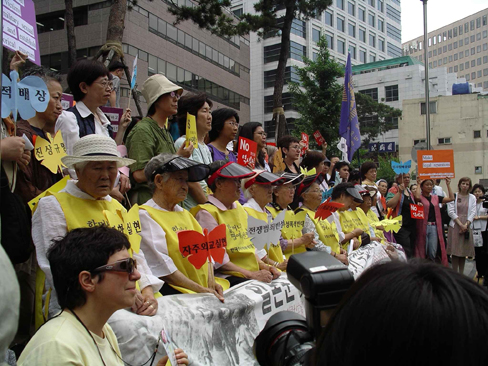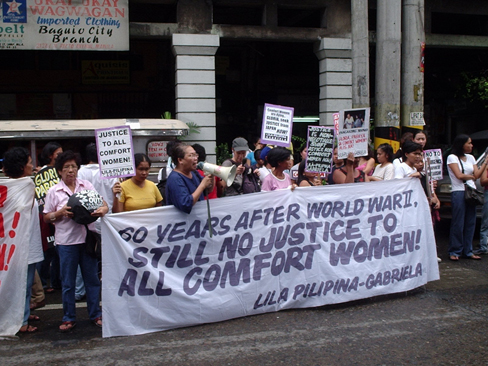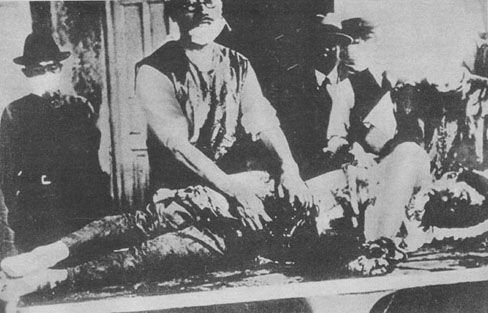The news of world affairs these days is highly unlikely to delight the Japanese survivors of the two nuclear terrorist attacks on Hiroshima and Nagasaki by the United States’ armed forces sixty years ago. Those attacks were not meant to convince the Japanese leaders to surrender, something which they were about to do anyway, but were intentionally carried out on civilian populations with the twofold goal of a) brandishing to the Soviets the US’s newly developed weapons of mass murder and b) studying the effects of these weapons.
Every new weapons system needs thorough testing. This is something familiar to the Japanese scientists and doctors who, before and during World War II, worked as members of Unit 731 studying the effects of biological weapons, as well as extreme cold, on human bodies, so as to devise preventative measures for the Japanese soldiers who by imperial order were to be sent to fight the Koreans, the Chinese, or the Russians. Those scientific leaders must have been dazzled by the audacity of their US counterparts in the testing of those two ghastly bombs on the Japanese civilian population.
What most depresses hibakusha may not be the fact that the current Prime Minister of Japan, Junichiro Koizumi, no longer regards it an obligation to speak to them or to their representatives after the annual official ceremonies marking these barbaric events (as has been the custom since the end of World War II).
More depressing must be the fact that the Tokyo School District is currently holding mandatory “re-education” classes for the teachers who, as a result of exercising their freedom of speech and movement, are being punished for not standing up for the nation’s flag and refusing to sing the national anthem. Indeed, utter and total respect for the flag and the anthem is required by law in the Tokyo School District, under the right-wing governorship of Mr. Shintaro Ishihara, the author of the famous ultra-nationalist book about Japan’s aggressive self-assertion, entitled The Japan that Can Say No: Why Japan Will Be First Among Equals.
Equally depressing must be the refusal of Prime Minister Koizumi to stop visiting the Yasukuni Shrine in Tokyo, home to the remains of two and half million soldiers of Japanese wars (all of which have been aggressive wars of invasion and colonization), as well as home to the remains of Japan’s convicted war criminals of the World War II period.
The most depressing is what everybody knows yet gets zero negative mention in the official press, especially the right-wing newspapers such as the Yomiuri Shimbun, or its associated papers and magazines: the shame of Japan’s rapid remilitarization, much encouraged and helped along by the US since at least the 1990s, and greatly accelerated since the coming to power of George W. Bush.
The International Herald Tribune of August 8, 2005, reporting on the atomic bombings’ anniversary ceremonies in Hiroshima, described the survivors’ mood as somber and anxious. One survivor interviewed by the newspaper, a physician, summed up well how the sands have shifted. “Ten years ago, few could question Article 9 of the Constitution [which bans participation in offensive wars]. But people talk about it openly now.” Another survivor, Akihiro Takahashi, former director of the Peace Memorial Museum in Hiroshima, was quoted as saying, “The dispatch of the Self Defense Forces to Iraq is completely out of line with pacifism. In the future the peace constitution will no doubt be revised, and that will lead to conscription and, eventually, the possession of nuclear arms.”
And so it is that, sixty years later, some Japanese have opportunities to become true descendents of the scientists and doctors of Unit 731 who made careful studies of the slow death of Chinese and Korean people in those macabre laboratories. Their forefathers tested the effects of various diseases as well as the effects of extremely low temperatures on human bodies scientifically. “Testing,” of course, did not mean that the effects of such diseases such as typhoid, dysentery, and cholera (typically left behind by Russian soldiers) were countered after the initial symptoms manifested themselves. No. Thoroughness above all! The effects were studied to the point of death. In some cases, after being exposed to such diseases, the “subjects,” upon showing signs of relevant symptoms, would be placed on the butcher’s block while conscious, and a thorough vivisection would ensue to study the effects of particular diseases on internal organs.
The spiritual descendents of those scientists, in turn, may indeed be conducting team research with (or may be looking into the data gathered by) their Yankee, Brit, and Israeli brothers-in-law, in detention centers all across Iraq and Afghanistan, where torture is common practice.
Fateful Formations
From the inception of its “opening” to the West (the Meiji Restoration of 1868), Japan began to embrace not only the socio-economic relations of capitalism and the intellectual school of rationalist (and technological) enlightenment that represented the best of the West. But, through a very astute study, Japan understood clearly the political and not so enlightened underpinnings of this new economy. War and imperialism, as discerned clearly by the Meiji reformists, were the primary factors that rendered possible the very conditions for the spread of this capitalist world system. In this new world system, there were no options for playing the role of innocent bystanders; you either pillaged others, or got pillaged.
Jon Halliday, in his book A Political History of Japanese Capitalism, has shown that, from the beginning of the capitalist transformation of Japan, her ruling classes were aware that the development of their modernity required ever increasing use of ancient methods of warfare, outright plunder, and subjugation of colonies in one form or another. So, from the early days of their modernizing, the Japanese rulers studied not only the Western countries’ modern sciences and philosophies and manufacturing and management methods but also the myriad aspects of colonial administration.
And the Japanese rulers put their studies to use. In Manchuria, they adopted a colonial rule-by-proxy method, while in Korea and Taiwan annexation was the preferred tool. In places like China where there were colonial rivalries that pit various European powers against each other or against the US, Japan would exploit those divisions.
It is also important to bear in mind that Japan is a country infamously poor in its own sources of energy as well as raw materials such as metals and minerals. As stated by Halliday, “The lack of raw material in Japan and the pressure applied against Japan by the unequal treatise led to the delay in the development of a heavy industrial base. But as the unequal treaties were revised and Japan engaged in expansion, a heavy industrial base became a vital necessity, particularly to cope with the large military building program. Clearly, Japan could not continue to have its navy built in England.”1
But this expansionist urge was not fueled merely by the need for raw materials. The need for the acquisition of colonies was integral to the development of capitalism per se in Japan. “Politically, the Meiji oligarchs were content with a rural and rural-based policy. The compromise between the feudal lords and the bourgeoisie did not allow the latter to destroy the medieval structure of agriculture. Colonization was one way to reduce the contradictions between industry and the preservation of feudal relics in the economy as a whole.”2
The first Japanese assaults on China, the Sino-Japanese War of 1894-95, at a time when European powers had (for about forty years) been attempting to carve out various parts of China, led to a strategic alliance with Britain, signed in 1902 (which lasted until the conclusion of the Washington Conference in 1922). The alliance was beneficial to England, since it provided her with a key ally with its own motives to move against Russia, a historical enemy of Britain, since Russia had its own designs on Manchuria and therefore was a strategic enemy of Japan.3
This alliance with Britain in turn paved the way for the Russo-Japanese War of 1904-05, in which Japan defeated Russia, thereby establishing herself as a serious contender in the international colonial and imperial games.
So, by the early twentieth century, as explained by Halliday, “Japan had surprised the Western powers. . . . It had entered the imperialist club and won Taiwan. . . . But, the lesson was that without a countervailing alliance other imperialist powers would tend to sabotage any Japanese successes.”4
That moment of arrival, exactly a century old by now, proved not only fateful but definitive. Korean annexation followed shortly after that in 1910, and increasing military expansionism would ensue, climaxing in a vast tragedy — a tragedy awaiting repeat performance if the right wing militarists in Japan have things their way.
Another pattern common in imperialist countries’ economic development is manifest in the relation between Japan’s economy and her foreign policy. Christopher Howe has demonstrated that the biggest expansions in Japanese export up to 1945, for example, coincided with Japan’s various aggressive wars for acquisition of colonies and during the two World Wars.5
Clearly war is good business for some.
Japan’s imperialist behaviors have continued to this day, even though the penetration into new markets has not always been accomplished by war. Surely a mature system of imperial acquisitions needs periods of peaceful accumulation and naturalization as well. But, even and especially in peace times, in trade agreements and development aid programs, Japan is every bit as predatory as the US, and her lending practices every bit as Shylock-like as the IMF’s and the World Bank’s.
In the general context of the colonizing process, what the military invasions are meant to do is obviously to stake out territory, plain and simple. Such conceptualizations as “the battle for hearts and minds,” “the civilizing mission” (as the Europeans liked to call it), and the “Greater East Asia Co-Prosperity Sphere” (as the Japanese propagandized) are absurdities put forth for the consumption of the people living in the bellies of the respective beasts at the center of the current world system. What else are they to call it? Rape and pillage?
While the circus side of bread-n-circus show is handled by technicians of ideological state apparatuses such as the media and education systems of imperial countries, invaded societies are forced to change according to the wishes of the invaders, who are bent on exclusive contracts and concessions. In other words, an integration of colonized societies into the colonizer’s system of capital accumulation is demanded. Once integration favorable to the colonizer has been (forcefully) formalized into law, then the colonizer’s army may leave. The country has been branded, and its future economic survival has become conditional on the interests of the powerful at the center.
For example, take Japan’s attempts to integrate Chinese economic resources into its own economy. In 1915, during World War I, China, knowing that the European powers’ armies were preoccupied with other fronts, demanded a total withdrawal of all foreign armies from Chinese soil. Japan, recognizing her chances for extortion, put forth a list of demands, known as the Twenty-one Demands, all to do with exclusive rights and concessions that Japan wanted to extract from China. After much “negotiation,” China conceded to most Japanese demands.
Eventually, however, the early Japanese successes had to be checked — the US and European imperialists stepped in and put Japan “in its proper place,” as a junior imperialist club member, in the Washington Conference of Nov. 1921- Feb. 1922.6
The Upgraded Model
Fast forward to today. By now, the Japanese system is as sophisticated as any run by Western European powers or the US, though, of course, without as much military hardware — yet.
Take for example the aid mechanism. According to Walter Hatch and Kozo Yamamura’s book, Asia in Japan’s Embrace, the Japanese government’s aid program is marked by three fundamental characteristics. First, it tends to initially focus on developing the infrastructure of countries which Japanese corporations wish to penetrate but which lack necessary infrastructure for their smooth operations. Second, the aid program is heavily loaded with credit, as opposed to grants.7 This has the obvious advantage of more securely integrating recipient nations into the Japanese financial-industrial infrastructure. Third, the Japanese government’s development aid packages, much like those of the US, come with inelastic strings attached. Primarily, such “aid” requires expenditure of the money on goods and services sold by Japanese corporations. Further, receiving “aid” is not only contingent on spending it back in Japan, but even contingent on getting advised by Japanese consultants on how, where, and when to spend it.9
But, more fundamental than the aid packages and the dependency relations they reinforce is how the Japanese capitalist production system is regionalized in East and Southeast Asia. As explained by Hatch and Yamamura, today Japan’s manufacturing is a three-tiered system based on a hierarchical division of labor. “Japan usually supplies the high-tech inputs; the Asian NICs [Newly Industrialized Countries; e.g. Taiwan and South Korea] supply the high-to medium-tech inputs; and the ASEAN-4 nations [Thailand, Philippines, Malaysia, and Indonesia], as well as China, supply the medium-to low-tech inputs.”9
In case some still believing in the liberating powers of the invisible hands of the market or the infamous theory of “comparative advantage” claim that the three-tiered system works to everybody’s advantage in the long run, it must be pointed out that the entire purpose of this system is to protect the monopolistic position of the Japanese as much as possible, by rigidly maintaining exactly the same hierarchical system, ad infinitum.
The system that the Japanese multi-national corporations (with active and comprehensive participation of the Japanese government) have developed over time is one in which more and more Japanese companies operate in an increasing number of countries in Southeast Asia in a way that maximally excludes the local suppliers and manufacturers from the general production circuits that dominate the world markets for manufactured goods and financial services.
History Calls
Readers of Immanuel Wallerstein‘s works, and those who generally find in the World-Systems Analysis the clearest explanatory theory around for the state we are in, know that the world capitalist system is at a bifurcation point. The system has reached its outer limits and is disintegrating. What will be the outcome of this disintegration and what kind of social formation will replace it will be determined by current struggles as well as those ahead.
In this crisis, the Japanese ruling class, who are highly systematic if nothing else, believe that their class survival depends greatly on their alliance with the Anglo-Saxon axis and participation in wars of expansion, to conquer more monopolistic positions and acquire increasing investment opportunities by any means necessary.
So, the Japanese developments to watch out for, above all, are a) Japan’s stance toward the North Korean “nuclear issue” (coupled with the issue of the North Korean abduction of the Japanese citizens); b) the disputed Exclusive Economic Zones that form the quasi border between China and Japan in the East China Sea, which is really a dispute over access to energy reserves; and c) Japan’s handling of the question of Taiwan.
One group of activists who have been tirelessly educating the public about how the terror of wars affects women, as well as speaking out for reparations for violations they suffered at the hands of Japanese soldiers, are the so-called “Comfort Women.” Perhaps the best piece of news his year for any group of people who survived World War II was the opening of the Women’s Active Museum on War and Peace, Japan’s first ever resource center on sexual slavery before and during WWII, which opened in Tokyo on August 1.
Another related piece of good news was the spread of solidarity with the survivors of the Japanese Imperial Army’s sexual slavery. On a Global Action Day, on August 10, women worldwide held demonstrations in front of Japanese embassies and consular offices, demanding legal and full compensation for the survivors, a full and unambiguous apology from the Japanese government, and the implementation of recommendations made in this regard by the United Nations and the International Labor Organization.


The next stage of history is being made today, at the world system’s bifurcation. It is not simply up to generals and gun-toting goons to determine history’s outcome. We, too, are historical actors, positively alive agents who can and must affect the outcome of this historical period. As a revolutionary once said, “You may not be interested in history; but history is certainly interested in you!”
Footnotes
1 Jon Halliday, A Political History of Japanese Capitalism, Pantheon, 1975, p. 101.
2 Ibid, p. 102.
3 Ibid, p. 82.
4 Ibid, p. 86 (emphasis in original).
5 Howe, Christopher; The Origins of Japanese Trade Supremacy, Chicago, 1996. See especially Table 5.1 and its related explanation, p. 116, and Table 5.2, p. 117.
6 Halliday, p. 98-99.
7 Walter Hatch and Kozo Yamamura, Asia in Japan’s Embrace, Cambridge, 1996, p. 124 (emphasis added).
8 Ibid, p. 126.
9 Ibid, p. 23.
Reza Fiyouzat is an applied linguist/university instructor, and a freelance writer. He may be reached at <[email protected]>. He keeps a blog


